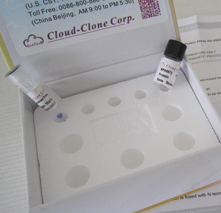地高辛
- CAS编号 20830-75-5
- 分子式 C41H64O14
- 分子量780.94
- Beilstein号 77011
- EC号 244-068-1
- MDL号 MFCD00003674
- PubChem编号 2724385
产品属性
| pH | 对光线敏感 |
|---|

| pH | 对光线敏感 |
|---|
| 产品名称 | 地高辛配基(洋地黄毒苷) |
|---|---|
| 英文名称 | Digoxigenin-Mono(digitoxoside) |
| 规格或纯度 | ≥98% |
| 运输条件 | 超低温冰袋运输 |
洋地黄毒苷-单氧菊酯(洋地黄毒苷)是地高辛(Dx)的代谢产物。
Digoxigenin-Mono(digitoxoside) is a metabolite of Digoxin (Dx).
| CAS编号 | 5352-63-6 |
|---|---|
| 熔点 | 200-210° C |
| 溶解性 | Soluble in DMSO and Methanol |
| 储存温度 | -20°C储存 |
| 分子量 | 520.65 |
| 分子式 | C29H44O8 |
| 品牌 | Jinpan |
| Smiles | C[C@@H]1[C@H]([C@H](C[C@@H](O1)O[C@H]2CC[C@H]3([C@@H](C2)CC[C@@H]4[C@@H]3C[C@H]( |
| PubChem CID | 93001 |

货 号:11745832910
产品规格:
原 产 地:roche
参考价格:3900 (参考价格,以实际价格为准)
优惠价格:
罗氏地高辛试剂盒11745832910
DIG-High Prime DNA Labeling and Detection Starter Kit I
For 12 random-primed DNA labeling reactions with DIG-11-dUTP, alkali-labile, and 24 color detection reactions with NBT/BCIP.
For life science research only. Not for use in diagnostic procedures.
Product No. Pack Size
11745832910
1 kit for up to 12 labeling reactions and detection of 24 blots, 10 ng to 3 µg DNA per assay, blots of 100 cm2
Convenient kit for random-primed labeling of DNA templates with DIG-11-dUTP, alkali-labile, and color detection of the DIG-labeled hybrids. In this method, the complementary DNA strand of denatured DNA is synthesized by Klenow polymerase using the 3′-OH termini of the random oligonucleotides as primers.This kit was assembled with convenience in mind, offering a ready-made blocking solution, combined stock solution of NBT/BCIP, and DIG Easy Hyb granules. The DIG-High Prime mixture includes stabilized Klenow Enzyme, nucleotides, primers, and reaction buffer, all in one convenient reagent.
Contents
DIG-High Prime, 5x concentrated
DIG-labeled Control DNA (5 µg/ml), pBR328 (linearized with BamH I)
DNA Dilution Buffer
Anti-digoxigenin-AP Conjugate
NBT/BCIP Stock Solution, concentrated
Blocking Solution, 10x concentrated
DIG Easy Hyb Granules
DIG-High Prime is used for the highly efficient random-primed labeling of DNA probes with DIG-11-dUTP, alkali-labile. DIG-labeled probes are generated at high yield within one hour or after overnight incubation. DIG-High Prime-labeled DNA probes are used in a variety of hybridization techniques:
Southern blots
Northern blots
Dot blots
Colony and plaque hybridizations
For all types of filter hybridization
For single-copy gene detection in total genomic DNA, even from organisms with high complexity, for example, human, barley, and wheat
Sample Materials
DNA fragments of at least 100 bp
Linearized plasmid, cosmid or λDNA
Supercoiled DNA
Principle
The DIG High Prime DNA Labeling and Detection Starter Kit I uses digoxigenin (DIG), a steroid hapten, to label DNA probes for hybridization and subsequent color detection by enzyme immunoassay. The “random primed” DNA labeling method originally developed by Feinberg and Vogelstein is based on the hybridization of oligonucleotides of all possible sequences to the denatured DNA to be labeled. The input DNA serves as a template for the synthesis of labeled DNA, and is not degraded during the reaction, making it possible to label minimal amounts of DNA (10 ng) with this method. The complementary DNA strand is synthesized by Klenow polymerase using the 3′-OH termini of the random oligonucleotides as primers. Modified deoxyribonucleoside triphosphates, labeled with digoxigenin present in the reaction are incorporated into the newly synthesized complementary DNA strand.
Quality
Function tested in a dot blot.
产品详细信息
罗氏地高辛试剂盒11745832910
DIG-High Prime DNA Labeling and Detection Starter Kit I
For 12 random-primed DNA labeling reactions with DIG-11-dUTP, alkali-labile, and 24 color detection reactions with NBT/BCIP.
For life science research only. Not for use in diagnostic procedures.
Product No. Pack Size
11745832910
1 kit for up to 12 labeling reactions and detection of 24 blots, 10 ng to 3 µg DNA per assay, blots of 100 cm2
Convenient kit for random-primed labeling of DNA templates with DIG-11-dUTP, alkali-labile, and color detection of the DIG-labeled hybrids. In this method, the complementary DNA strand of denatured DNA is synthesized by Klenow polymerase using the 3′-OH termini of the random oligonucleotides as primers.This kit was assembled with convenience in mind, offering a ready-made blocking solution, combined stock solution of NBT/BCIP, and DIG Easy Hyb granules. The DIG-High Prime mixture includes stabilized Klenow Enzyme, nucleotides, primers, and reaction buffer, all in one convenient reagent.
Contents
DIG-High Prime, 5x concentrated
DIG-labeled Control DNA (5 µg/ml), pBR328 (linearized with BamH I)
DNA Dilution Buffer
Anti-digoxigenin-AP Conjugate
NBT/BCIP Stock Solution, concentrated
Blocking Solution, 10x concentrated
DIG Easy Hyb Granules
DIG-High Prime is used for the highly efficient random-primed labeling of DNA probes with DIG-11-dUTP, alkali-labile. DIG-labeled probes are generated at high yield within one hour or after overnight incubation. DIG-High Prime-labeled DNA probes are used in a variety of hybridization techniques:
Southern blots
Northern blots
Dot blots
Colony and plaque hybridizations
For all types of filter hybridization
For single-copy gene detection in total genomic DNA, even from organisms with high complexity, for example, human, barley, and wheat
Sample Materials
DNA fragments of at least 100 bp
Linearized plasmid, cosmid or λDNA
Supercoiled DNA
Principle
The DIG High Prime DNA Labeling and Detection Starter Kit I uses digoxigenin (DIG), a steroid hapten, to label DNA probes for hybridization and subsequent color detection by enzyme immunoassay. The “random primed” DNA labeling method originally developed by Feinberg and Vogelstein is based on the hybridization of oligonucleotides of all possible sequences to the denatured DNA to be labeled. The input DNA serves as a template for the synthesis of labeled DNA, and is not degraded during the reaction, making it possible to label minimal amounts of DNA (10 ng) with this method. The complementary DNA strand is synthesized by Klenow polymerase using the 3′-OH termini of the random oligonucleotides as primers. Modified deoxyribonucleoside triphosphates, labeled with digoxigenin present in the reaction are incorporated into the newly synthesized complementary DNA strand.
Quality
Function tested in a dot blot.